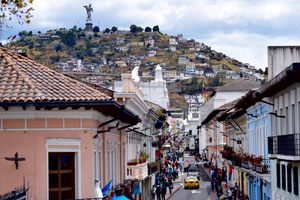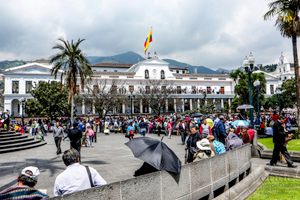About
La Virgen de Quito is a small wooden sculpture of the Virgin Mary, located above the main altar in the Church of San Francisco in Quito. For such a small statue, it has inspired an impressive degree of devotion, and innumerable replicas both big and small.
While commonly referred to as La Virgen de Quito, the statue goes by various names. Some call it the Virgen de Legarda (Legarda's Virgin), in reference to the Ecuadorian sculptor and painter Bernardo de Legarda, a preeminent figure in the Quito School of Art.
In 1732, Legarda was commissioned to create a sculpture of the Immaculate Conception for the Church of San Francisco in Quito. He presented his finished work in 1734: a 12-inch-tall wooden sculpture of the Virgin Mary, which instantly met with great approval for its beauty. The Franciscans were so inspired by the piece that they placed it in a prominent position above the main altar.
Other names given to La Virgen de Quito refer to its form, albeit in varying ways. When people call it the Virgen del Apocalipsis (Virgin of the Apocalypse), they are referring to the Woman of the Apocalypse described in Chapter 12 of the Book of Revelation, a winged female figure often identified as the Virgin Mary. Legarda’s sculpture was inspired by this text, his winged Virgin stamping upon a snake, a representation the dragon/Devil figure described in the Book of Revelation. People also call the statue La Virgen Alada (the Winged Virgin), in reference to the small wings that appear above her shoulders.
Another common name for the sculpture is the Virgen Bailarina (the Dancing Virgin). Unlike many sculptures of the Virgin Mary, which have a static appearance in comparison, La Virgen de Quito almost appears to be dancing. The position of her hands and the folds of her dress give her a sense of motion, a sway that won the hearts of the Quito faithful.
The popularity of Legarda’s sculpture soon led to the creation of numerous replicas, and countless smaller copies spread across Latin America. Other artists were inspired to create similar statues, some of which are now housed in museums across the globe, including the Ethnological Museum in Berlin and the Brooklyn Museum.
None, however, are quite as large as the Virgen de El Panecillo, a statue in Quito based on Legarda’s original 12-inch sculpture, but supersized to a towering 98 feet.
Know Before You Go
La Virgen de Quito is located above and behind the main altar in the Iglesia y Convento de San Francisco (Church and Convent of San Francisco). The church sits along Plaza de San Francisco and Calle Cuenca in the center of Quito.
Wild Galapagos: An Ecological Wonderland
Darwin's legacy, snorkeling, volcanic landscapes & conservation insights.
Book NowCommunity Contributors
Added By
Published
February 15, 2019























